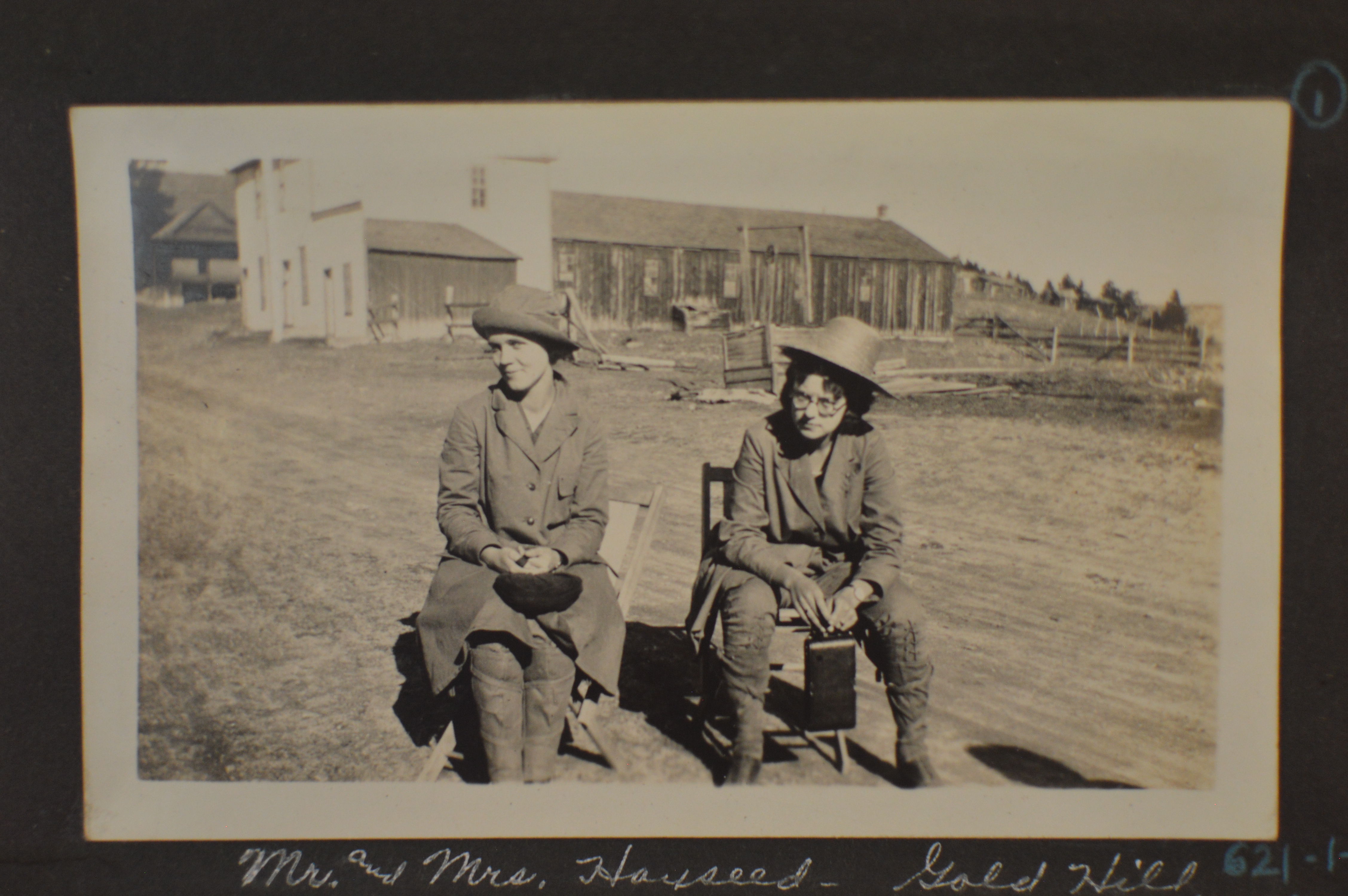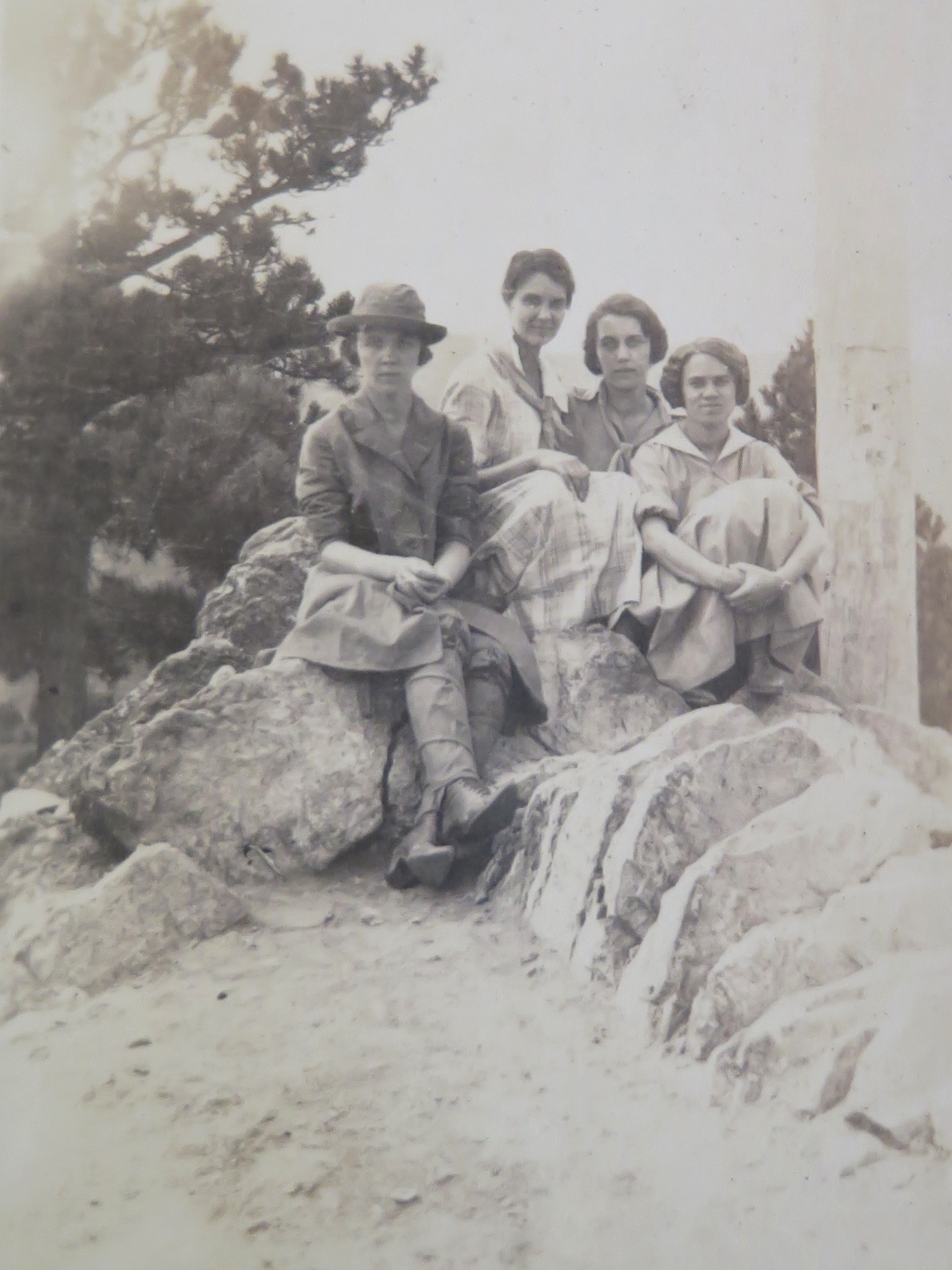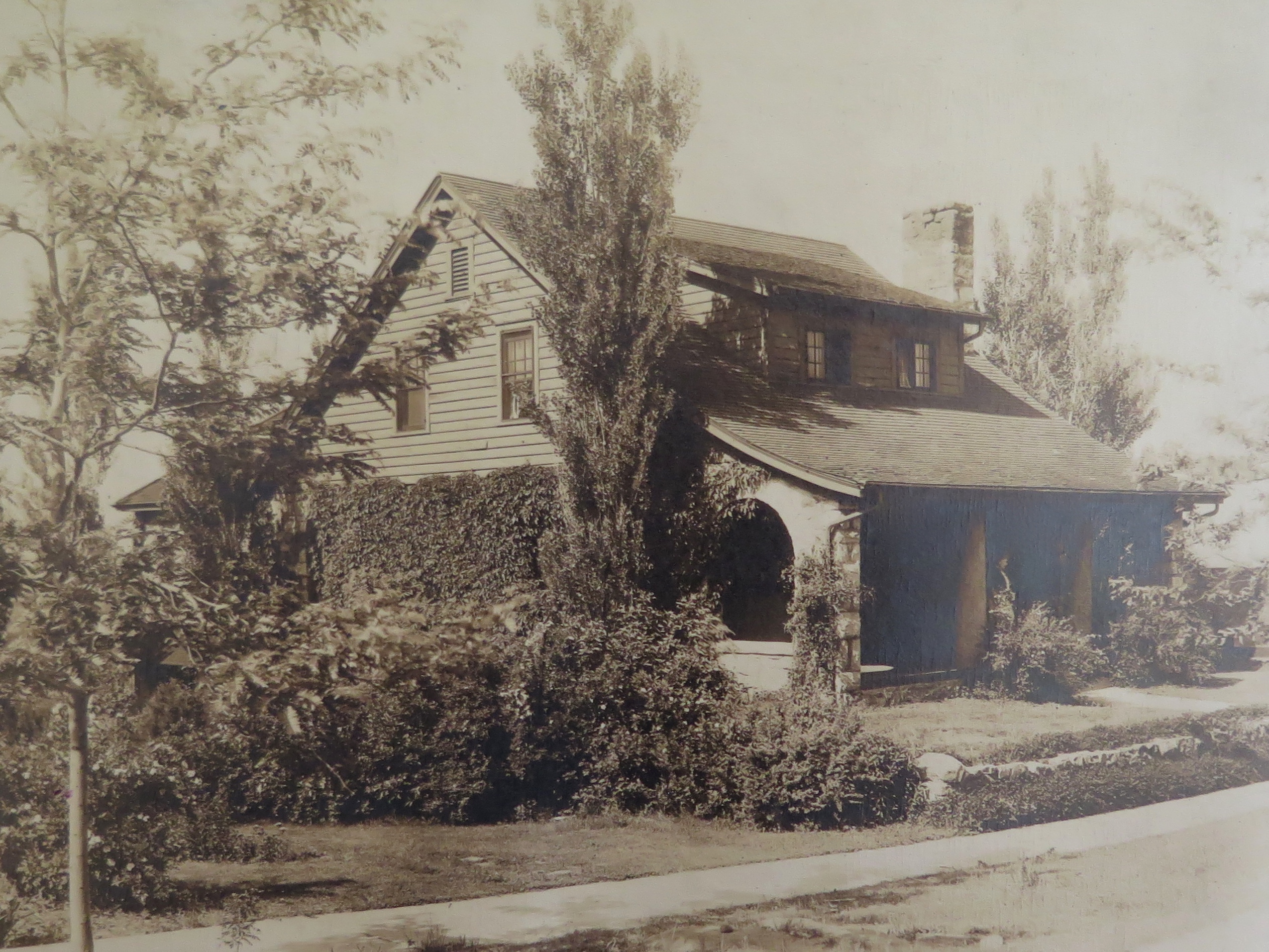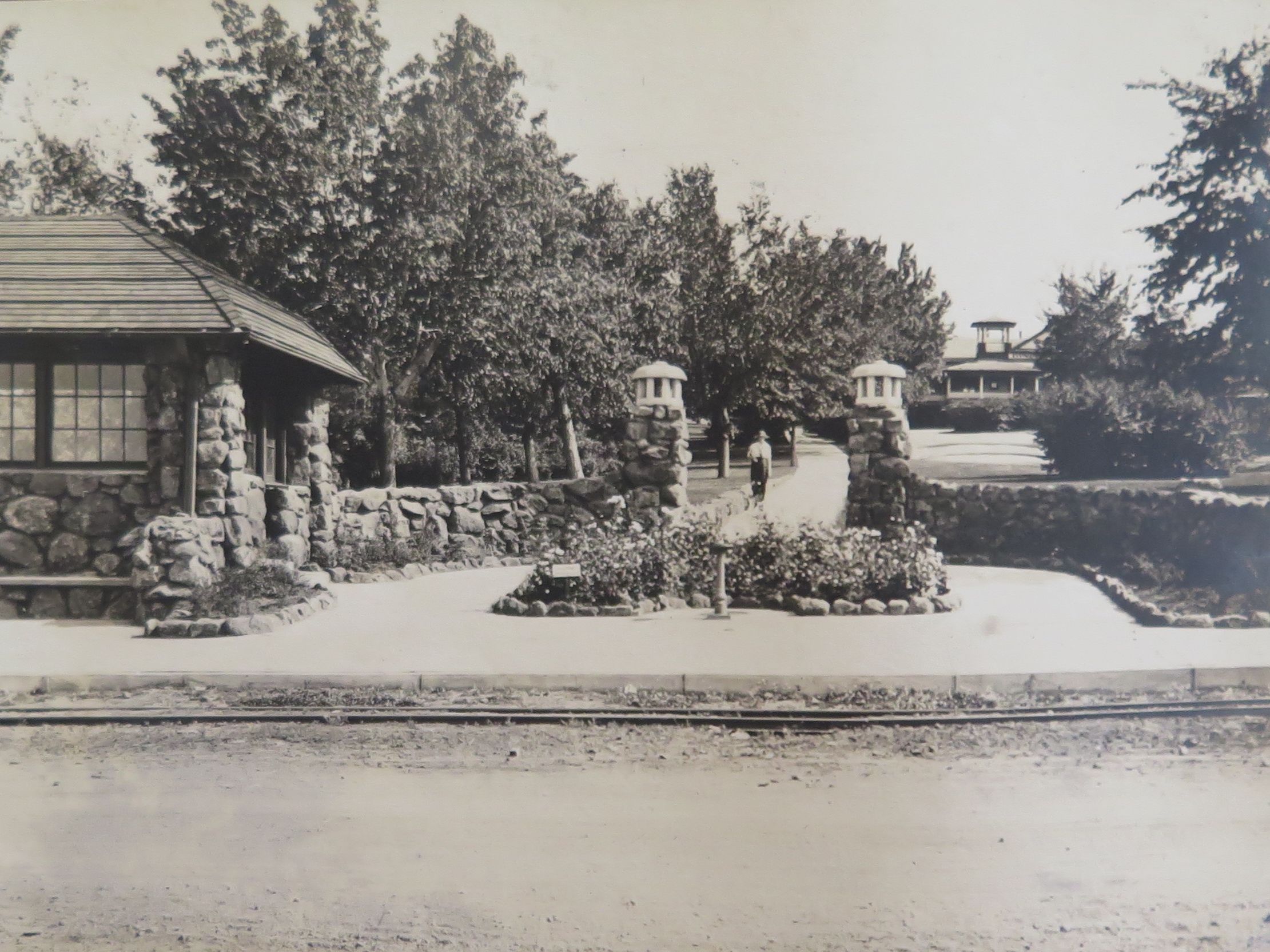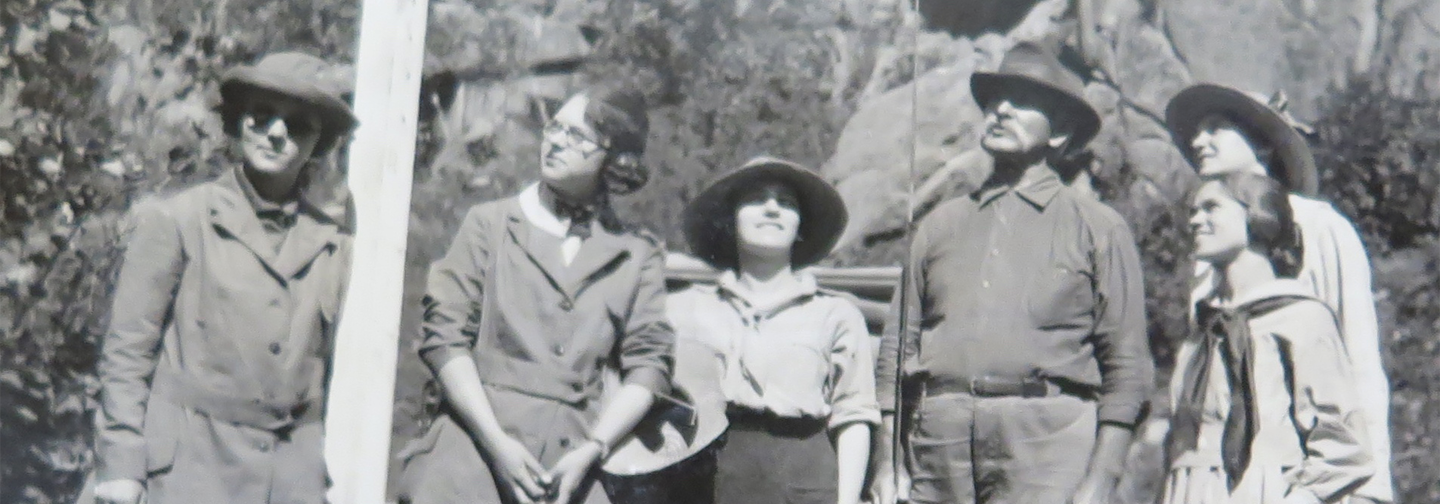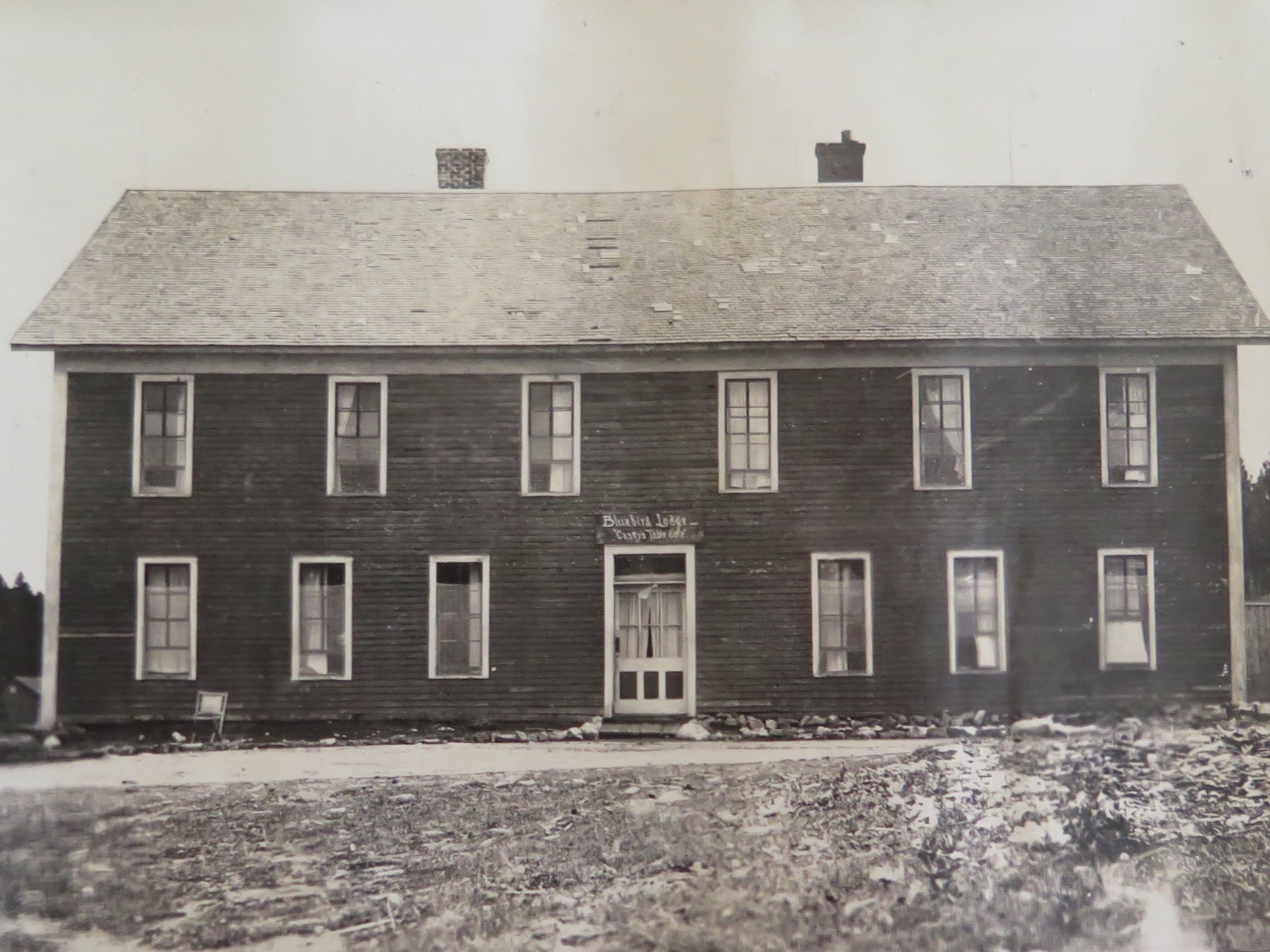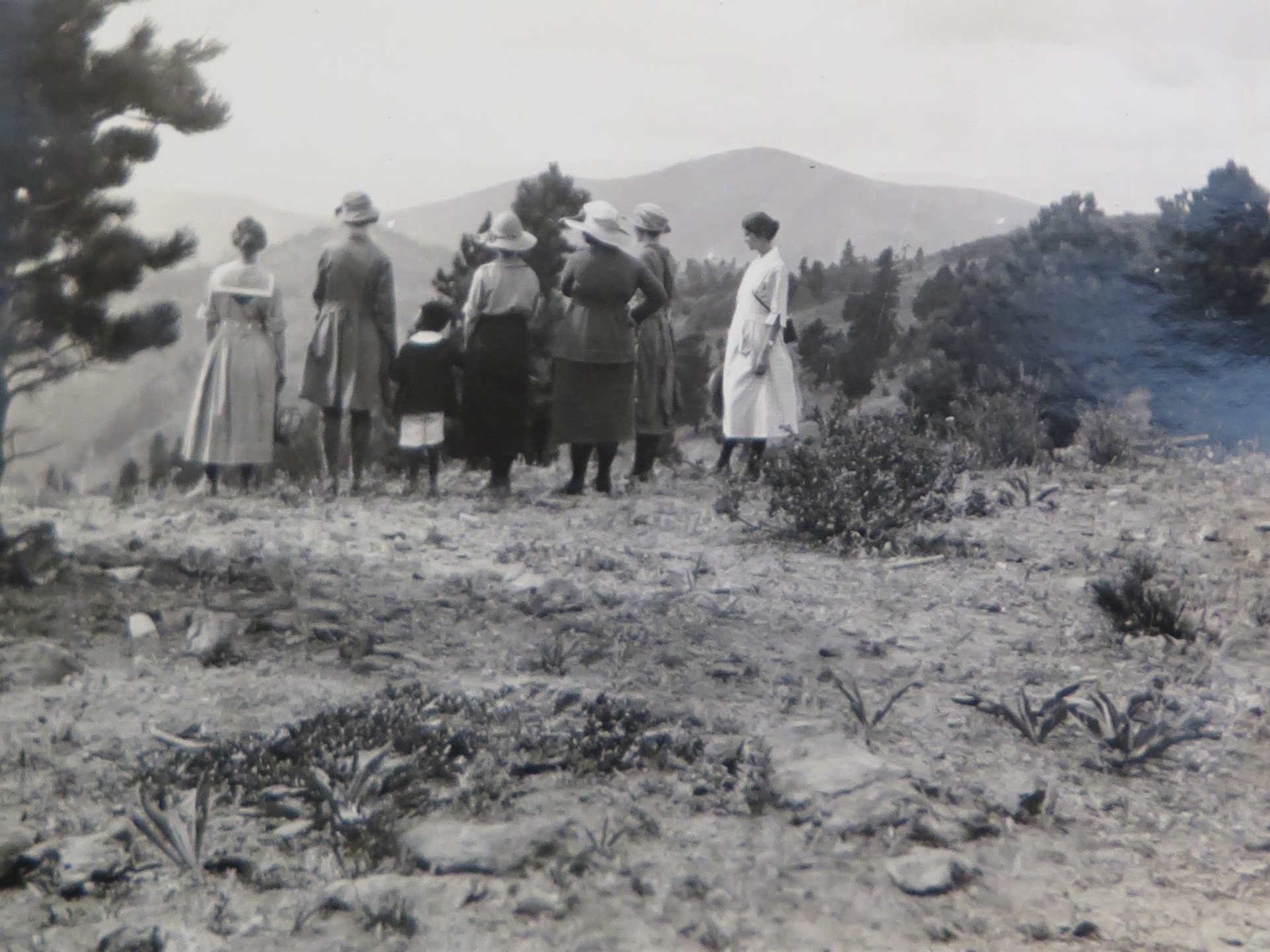
Story
In the Land of Sky Blue Weather
The Mystery of the Blue Bird Club Photo Album
A forgotten photo album reveals a window into the experiences of women enjoying independence and female friendship amid Colorado’s spectacular Rocky Mountain landscapes in the early twentieth century.
“Mr. and Mrs. Hayseed—Gold Hill” declared the caption beneath the vintage photograph of two young women in boots and knicker pants seated in the open air, a row of wooden buildings forming a weathered backdrop to the rustic scene. Part of a historic photo album in the Blue Bird Club collection at the Boulder Carnegie Library for Local History, the names implied humor in the women’s relationship, as well as a certain city sensibility brought to the Colorado mining town they were visiting.
I first learned of the Blue Birds on my own trip to Gold Hill, a charming hamlet in the mountains above Boulder, for dinner at the acclaimed Gold Hill Inn. Peeking in the window of the old lodge next door, I read that a Chicago women’s organization called the Blue Birds had owned the building from the 1920s to 1960s. They had built what was now the Inn, in fact, as their club kitchen, dining, and living rooms. Wondering who these women had been and what they had been doing in my neck of the woods, I resolved to find out more—someday.
I returned to the Blue Birds when a friend and I kicked around the idea of a book about women’s friendships in the West. At the Boulder Carnegie Library for Local History, I leafed through old scrapbooks in the club’s archives and enjoyed black and white photographs of women in riding breeches, lace-up boots, and wide-brimmed hats on horseback or riding in the 1920s touring car that ran between Boulder and Gold Hill in the organization’s heyday. I marveled at the idea of Blue Birds in full skirts hiking early Chautauqua trails, where, even with improvements in the years since then, some of the paths are still steep or slick enough that I struggle in jeans and hiking boots today. And they didn’t grow up at high altitude, like I did.
As I dipped into research, I decided the Blue Birds deserved a book of their own. I was drawn to their story of early-twentieth-century “New Women” embracing the natural world for recreation and companionship in the Colorado mountains. I wanted to know more about these single, urban women who came west from Chicago on the railroad to vacation with other “self-supporting” women, as they were called in those days.
On my third trip to the Boulder Carnegie, I discovered the vintage photo album—the best artifact I had yet encountered in my research as a record of a typical Blue Bird vacation, dated from the first year members stayed at the club’s newly purchased lodge in Gold Hill. The unnamed creator of the album had even titled it as a travelogue in elegant handwriting on the inside front cover: “In the land of the sky blue weather, Boulder, Colorado, August 14–30, 1921.”
Here were candid glimpses into the lives of the women who called themselves Blue Birds. Photographs of founder Jean Sherwood in her beloved cottage garden. Blue Birds in calf-length skirts posed at Boulder’s Flagstaff Mountain and Royal Arch. A Model T “stage” used by A.J. “Tim” Walter to chauffeur Blue Birds on steep dirt roads between Boulder and Gold Hill—highlighted by the caption “A thrilling ride we’ll say!”
In these photographs showing Blue Bird activities in the club’s earliest years, this small album, with its black, tattered pages unbound from the shabby cover, offers a rare portal into the experiences of women enjoying independence and female friendship amid Colorado’s spectacular Rocky Mountain landscapes in the early twentieth century. The album records a visual log of Blue Bird excursions in Boulder and the Rocky Mountains, a portrait of the club women themselves, as well as the historical appearance of the structures they built as headquarters for their adventures. And what adventures they had, exchanging Chicago’s city streets for Colorado’s mountain paths!
I wanted to get to know these women. Two of them, in particular, caught my eye: “Mr. and Mrs. Hayseed.” Who were these intrepid women venturing so far from home?
The Blue Bird Club was founded by Jean Sherwood, a Chicago art teacher and philanthropist who came to Boulder for the first Texas-Colorado Chautauqua season in 1898. Sherwood and co-teacher Matilda Vanderpoel loved the beautiful natural scenery surrounding the emerging city of Boulder, hatching a plan to create a vacation home for self-supporting Chicago women, which meant predominantly white women working as sales clerks, secretaries, nurses, and teachers. In 1906, Sherwood bought four lots at Twelfth Street and Park Avenue, now Baseline, near Chautauqua Park, and then founded the Holiday House Association to raise money, including through $10 lifetime memberships, to build Blue Bird Cottage there.
Although some of the Chicago Art Institute men whom Sherwood approached for funding thought Colorado was too far for women to go on their own, Sherwood, Vanderpoel, and the women on the newly formed Holiday House board knew better. Blue Bird Cottage, a twelve-room, gabled stone rubble bungalow designed by Boulder architect Arthur E. Saunders, opened on June 15, 1911—one of the first houses built on the grassy hillside directly below Chautauqua Park. In July, stenographer Emma Tracy came for a vacation and stayed on as business manager until 1951. Forty-three women stayed that first summer at Blue Bird Cottage, named, according to Sherwood, for a mountain bluebird that made her nest in the bungalow’s porch during construction.
By 1935, the club’s twenty-fifth season, Blue Birds had made 5000 visits by rail from Chicago to Boulder County to find the good health, rest, and “inspiration given by mountain altitudes and rarely beautiful scenery” promised in Blue Bird brochures. Some members even bought property in Boulder and Gold Hill, reviving that small town not only through real estate deals, but with money spent for local entertainment like horseback rides and ice cream cones in newly opened businesses. An anonymous writer in a 1941 bulletin remembers spending “good old Chicago money” on “Coca-Cola, Seven Up, Dr Peppers, ice cream and Coor’s [sic], brewed from sparkling mountain waters” at the Gold Hill Café.
Part of my larger book project on the Blue Birds is mapping the collaborative women’s community they created, particularly in Gold Hill. The little photo album piqued my interest because it expressed the joy of single women vacationing with other women, a novel experience for its day. I also love a good historical mystery, especially one I sense has genealogical roots. Perhaps I could find out who Mr. and Mrs. Hayseed and other members were by researching the remaining Blue Bird club bulletins in the Boulder Carnegie Local History and Gold Hill Museum Special Artifact collections and tracing names through the genealogy database Ancestry.com.
When I first encountered the photo album, I asked Carnegie librarian Wendy Hall for any information the library had on its acquisition. According to the donation record, the album was given by Elizabeth Autry Jernigan of Mobile, Alabama, the year before. When Ms. Hall called the number on the form, Mrs. Jernigan’s son sadly informed her that his mother had died the previous Saturday. The only information he could tell us was that his mother purchased the album from an estate sale. Although the pages were worn and the binding was no longer intact, she had recognized the photographs’ historical value and sent the pieces to Boulder’s Carnegie Library for Local History. Her son said his mother liked to buy things she thought were of historical interest and donate them to libraries and museums. Unfortunately, it would be impossible to trace from which estate the album had come, because the sale included items from many different estates. Although we had missed the chance to talk with Jernigan herself, I became even more determined to trace the provenance of her gift.
The first page of the album contains a photograph of a mountain goat in the foothills, a creature curious enough for any tourist to memorialize. The picture next to it is of the person the Carnegie record refers to as the “album creator,” the same young woman properly posed with a playful smile in “Mr. and Mrs. Hayseed.” Captioned “Ready for a Hike,” this photograph of the Blue Bird in her hiking suit about to drink from a stone water fountain was taken across the street from Blue Bird Cottage at the former trolley stop next to the beautiful Chautauqua Park, where members hiked and attended programs during their stay.
The same jaunty woman appears throughout the album. In “On one of our climbs,” she poses near boulders with three Blue Birds in cotton blouses and neckerchiefs, while in “Among the rocks,” she shelters in between what looks like the redstone slabs of Boulder’s distinctive Flatirons. In another, she points to a window of the newly purchased lodge in Gold Hill; the caption reads, “Pointing out Eugene Field’s room at Bluebird [sic] Lodge,” referring to the poet who wrote “Casey’s Table d’Hote” in honor of Gold Hill’s mining days during his 1879 stay at the former miner’s home-turned-tourist hotel. Or perhaps, with her face turned away from the camera, it is the other woman of the “Hayseed” pair who points?
Providing outdoor experiences for city women was essential to the Blue Bird vacation. Club president Jean Sherwood believed in Colorado’s climate as a curative for long hours of indoor work. In an August 8, 1927, Christian Science Monitor interview, she said, “I know of nothing better for a girl who comes out here tired than to give her a sandwich lunch and let her spend the day alone in the mountains. [P]arties of girls with a guide go out on three-day trips, sleeping under the stars at night. As for clothes, it’s just a knicker suit and a sport shirt.”
An October 1932 Blue Bird bulletin extolled the difference between the mountains and the city in a reminiscence of “Audubon, Arapahoe, Long’s and Meeker, which dwarf and cheapen the showy towers of Michigan Avenue which dominate our working days . . . We remember the snap there was to living up there in contrast to our limp days in the Chicago heat.” According to a 1912 La Follette’s article by “One of the Girls” (a.k.a. Eda Kunz, according to Sherwood’s note in a Blue Bird scrapbook in the Carnegie collection), “Day after day girls would come worn out and hopeless, too tired to do anything for a week but sleep and eat, and at the end of another week full of life and spirit, eager to climb every mountain within sight.” By the 1930s, the Blue Birds embraced what were called “sunbaths,” clothed, of course, in cotton slips, with Sherwood writing “real ultraviolet rays make for rugged health” while “the Colorado sunshine never ceases its healing powers at all seasons.”
Railroad companies realized the potential for travel between Chicago and Boulder, eventually creating special Blue Bird excursions with devoted staff and fancy brochures that described the wonders of the Colorado mountains in elevated language such as this passage from the Burlington Railroad: “Here the sky has the rare view of an Italian sky; the pines blow balsam breath, heartening to weary bodies and minds.” The rate in 1921 was $30 round trip.
But the crisp mountain air and wilderness immersion brought more than good health. It brought independence to city women in new ways. For perhaps the first time in their lives, they weren’t traveling with parents or brothers, nor did they have to be married to travel. Instead, they traveled with other women, some whom they met en route, some who were friends and sisters, and others who became life companions and partners. A Blue Bird slogan could have been “Come for the air, stay for the freedom.” As Chicago journalist Lena McCauley, herself a board member, wrote in her 1912 Chicago Evening Post column: “The feeling of having a summer home of your own helps independence.” It’s important to note that Colorado passed full suffrage in 1893, the first state to do so by voting for it (men voting for it, that is). Illinois did not pass even limited suffrage for another twenty years, getting full suffrage only with national ratification of the 19th Amendment in 1920. For working women from Illinois, Colorado must have seemed a haven of progressive politics.
The Blue Birds embraced excursions for the sense of independence and adventure such expeditions fulfilled. In a 1922 talk, Sherwood called the area “A Rocky Mountain Playground.” A March 1931 Blue Bird bulletin proclaimed that “prowling around the mountains—helps digestion and sleep.” And prowl they did. Blue Bird excursions came in many packages: a ten-minute walk from Blue Bird Cottage brought hikers to surrounding canyons with whimsically named points of interest like the Witch’s Cabin and Enchanted Mesa. Those with a taste for “roughing it” could camp a few miles away in the mountains, including al fresco dinners called “steak-frys.”
Or they could go further afield, with day trips such as were noted in a 1916–17 brochure. For 80 cents, a Blue Bird could take a “tally-ho” horse-drawn coach ride twelve miles up Boulder Canyon to Boulder Falls for lunch and play. A dollar and a half bought a narrow-gauge trip on the Switzerland Trail railroad to Eldora, now a ski resort, or the other direction to tour deserted gold mines. In the earliest days, particularly hardy Blue Birds could make the three-day hiking and camping trip to Arapahoe Peak glacier, 14,000 feet high. (This trip closed to the public in the 1920s because the glacier supplied Boulder’s water and the city feared hikers brought risk of contagion.) The photo album includes several scenic views of favorite sites such as Boulder Falls and Flagstaff Mountain, while a Blue Bird scrapbook in the Carnegie collection contains an ad for the Denver-Central City “circle trip” with the notes “You may reverse trip start from Boulder” and “This automobile trip is taken by all Bluebird [sic] girls” in Jean Sherwood’s elderly handwriting.
For longer trips, the Blue Birds used the transportation services of Mabel MacLeay and Florence Molloy, two New York widows who started a Boulder taxi business in 1916. They took the Blue Birds on all-day excursions to Colorado Springs, Denver, and Estes Park, about fifty miles away on dirt roads in winding canyons. The photo album follows one Estes trip in the Model T driven by Molloy (“The machine we drove in to Estes Park”), with a stop in the St. Vrain canyon on the way up and another along the river in Big Thompson Canyon on the way down. Another photograph shows a bustling Estes Park, the tourist town where cars could be hired to visit Rocky Mountain National Park, established just six years earlier.
From the beginning, Jean Sherwood and Matilda Vanderpoel knew the fresh air and beautiful scenery of the mountain West provided the perfect place for single, working women’s adventures. A 1910 photo postcard in the Gold Hill Museum shows Sherwood and Vanderpoel on horseback visiting John and Mary Jane Cox, a Gold Hill mining couple from England who may have been related to Charles H. Cox who taught art with Sherwood and Vanderpoel at Chautauqua.
The mountain town must have impressed the women, for in 1919, when Blue Bird Cottage became too popular to accommodate all the summer guests, the club rented private cabins in Gold Hill until buying the old Wentworth Hotel for $350 in August 1920. The 1921 album includes a picture of the new Blue Bird Lodge before the wide veranda porch and dormer windows for attic sleeping were added and the wood siding removed to showcase its original log structure. The plaque over the door reads “Blue Bird Lodge” and “Casey’s Table d’Hote” in honor of Field’s poem.
In 1926, a second lodge with dining hall, living room, and kitchen was built next door by Tim Walter, owner of the “thrilling ride” motor stage. The original lodge was expanded to twenty-eight rooms, providing accommodations for sixty Blue Birds a week, according to a June 11, 1926, news article in Boulder’s Daily Camera. Other Blue Birds eventually purchased cabins in Gold Hill, including Matilda Vanderpoel, who in 1923 bought a former dry goods store-turned-cabin there with her sister-in-law, Marie, and in 1924 built her own artist studio on the same property.
In one photo of a group of Blue Birds enjoying the view from Gold Hill, I was particularly intrigued to find them holding hands with a young, African American child whose name is captioned elsewhere in the album as “Clifford.” The 1920 Gold Hill census and the Gold Hill Museum contain no information about him or his family, but in a search of all Colorado census records for 1920 I found an almost-five-year-old boy named Clifford Seymour living in Pueblo. The 1923 Pueblo city directory lists Clifford’s father, Matthew O. Seymour, as the President of Western Ideal Publishing Company; the 1930 census gives Seymour’s occupation as publisher of a newspaper. Researching early Black Colorado newspapers revealed Seymour’s The Western Ideal, published weekly from the late 1910s or early ’20s through the 1960s. How did Clifford get from Pueblo to Gold Hill? Perhaps his father came to cover a story or to visit a friend or relative. Whatever the reason, the Blue Birds in the photos seem to have taken Clifford under their collective wing. Many of them were teachers, after all, who no doubt would have welcomed the opportunity to befriend a small boy away from home.
It is also in Gold Hill that I found Mr. and Mrs. Hayseed, the same two women who appear together throughout the album. Their matching pants, leggings, and jackets tell us they were not previously strangers but rather were traveling together. Another photo shows them together at September Springs in Chautauqua’s Bluebell Canyon. Were they friends? Intimate companions? Sisters? Or cousins? Dressed so closely alike, I reasoned they were more likely to be sisters than friends, and perhaps close enough in age to have grown up wearing matching outfits. It was also likely that the women were siblings because 1920s parents would more likely allow sisters to travel together from Chicago to Boulder than they would a daughter alone, figuring they would act as chaperones for each other.
If the women were sisters, then the name written below two photos could provide the key to solving the mystery of the album’s ownership. In one, captioned “Ruth and I in Estes Park Big Thompson Canyon,” the pair sit on rocks jutting into the Big Thompson River, with the bespeckled Ruth looking a little worried about the water’s swift current, or perhaps squinting from the bright Colorado sun. We find her again sitting alone in a derelict train car, possibly at the old Red Rock quarry near the entrance to Boulder Canyon, in a photo simply captioned “Ruth.” And in a third picture, taken in the St. Vrain with a guide and other Blue Birds, their family resemblance is even more apparent.
With these clues in mind, I searched Blue Bird club bulletins for any mention of the name Ruth and found several, but a 1935 note in particular seemed promising. Here I found Ruth Zipperer in a list of returning members referred to as the “old guard.” From there, I turned to Ancestry.com, filling in her name and “Chicago,” with a guess at her age in 1921 as between eighteen and twenty-four years old.
To my delight, I found Ruth, born in October 1894, in a 1900, Peoria, IL, census record; with a sister named Dora born in September 1892, Dora became the likely creator of the photo album. Their father’s occupation was listed as “minister gospel,” perhaps of the liberal type that supported women’s education. Their mother had no occupation listed, meaning she was what we now call a “stay-at-home mom.” Both parents could read and write. The family also included three sons and the father’s German mother, for whom Dora is named. In 1910, I found the family living in Chicago, where the father is a “clergyman.” I was excited to see that one of the brothers worked in a picture frame shop. Perhaps photography was a family passion?
I knew for certain I had discovered the right sisters after I found a photo of Ruth in a 1916 yearbook of Chicago Normal College (which became Chicago State University in 1971). Here was the Ruth of the album photos with her brunette hair, round glasses, and inquisitive expression, as the poem next to her photo attests: “Ruth Zipperer is a serious maiden/who comes to school with arms book-laden.” She was a member of the Deutsche Gesellschaft (German Club) and the Junior Glee Club, a singing group.
These two sisters, raised by a minister father, educated mother, and immigrant grandmother, along with three younger brothers, followed two different paths typical for Blue Birds of their era. When they came to Colorado in 1921, Ruth was already an elementary teacher who may have learned about the Blue Birds from other teachers. Dora was the elder of the sisters by two years; it is her album housed in the Carnegie. I was surprised to discover that Dora was not only married when she accompanied Ruth to Colorado, but had a six-month-old daughter. Perhaps, following the norms of the day, the Zipperer parents would only allow Ruth to make the trip if Dora travelled with her. Colorado was 1000 miles from Chicago and may have seemed like quite a wilderness for city mothers and fathers worried about young women traveling away from home for what was likely the first time. Or perhaps Dora needed some time away from a new husband and baby.
Further records reveal that Ruth never married, becoming first a teacher and, in 1942, assistant principal at Howland Elementary in Chicago. Blue Bird bulletins show her returning to Colorado in 1935, leading sing-alongs at club meetings in the 1940s and working on membership drives in the 1950s. Sister Dora raised two daughters who grew up to join the Nursing Corp during World War II and a son who served in the war and later moved to California. I have not yet determined how Dora’s photo album found its way to an estate sale in Alabama, but, as with much family ephemera, it may have become separated from Zipperer descendents through neglect or the need to leave behind the artifacts of previous generations as families became more mobile.
As educated, financially independent “New Women” of the early twentieth century with life choices beyond the domestic sphere, members of the Blue Bird Club formed a women’s community—a space for single, self-supporting women to experience the freedom of nature—away from the city, and away from the supervision of male employers, fathers, and brothers. Even in their earliest days, the Blue Birds established a unique place for women to be independent and, as a group, self-sufficient through collaborative living with other women. As journalist McCauley wrote in 1914, “The [Blue Bird] household is united as a family, the outside world and the trials of the working ranks being forgotten. . . .” To be free within nature and unfettered by domestic responsibilities and restrictive gender roles—perhaps these freedoms are what truly precipitated a Blue Bird’s return to health.
After Jean Sherwood died at age ninety-two in 1938, the Blue Birds carried on. But as social restrictions on women loosened by the 1960s, women could travel alone and to pretty much anywhere they desired. Younger women, in particular, didn’t feel the need for even collaborative chaperonage. As the long-time Blue Birds aged and traveled less, the economics of running a cottage and a lodge didn’t pencil out.
In 1960, final Blue Bird president Mary Collopy explained how changes for women were affecting the organization: “In the ’20s and ’30s, girls wanted to travel in groups and their families wanted to know where they were and what they were doing.” Now the only ones who came were returnees: “The younger group just doesn’t come any more.”
In 1957, Blue Bird Cottage at Twelfth and Baseline was sold to a University of Colorado professor and his wife. Blue Birds continued to come to Boulder, staying in Chautauqua cabins and the lodge for a few summers more. In 1962, Blue Bird Lodge and dining hall were sold to a Gold Hill family, who turned the dining hall into the fine Gold Hill Inn still open today, with the original lodge only rented for special events. In 1966, Holiday House Association formally disbanded and disbursed their remaining assets to “do-good” nonprofit organizations.
But in the fifty-some years they operated, the Blue Bird Club brought thousands of working women to the Colorado wilderness, where they toured, hiked, rode, laughed, and lived alongside other women. In Colorado’s clean air, dry climate, and inspiring vistas, they experienced the connection between health and nature, a prime imperative behind wilderness preservation today. As forerunners and shapers of what by the time of their demise was known as “women’s liberation,” they gained social and financial independence through group governance and freedom from patriarchal strictures. They raised their own money through investments and real estate, and they spent their own money, too, reviving Gold Hill in the process. Like the Gold Hill miners before them, they looked to the hills for treasure, but what the Blue Birds found was love of the mountains, their freedom, and each other.
I looked for Ruth again while cross-referencing 1960s property assessments with 1964 Blue Bird membership cards, the only extant list of members in the Carnegie collection. As I picked up the envelope for W–Z, I hoped I might find Ruth’s name in the stack, but I didn’t skip to the end to find out. The researcher in me went card by card, just as I had for every other envelope. As I approached the end of the stack, I felt tingly. Was Ruth still a member forty-three years after she and Dora had come west together for a mountain vacation with other women?
And suddenly there she was on the last card of the bunch: Ruth Zipperer on Troy Street in Chicago. She had been a Blue Bird since 1921, the first summer the Blue Birds stayed in the Gold Hill lodge. She had returned for the 25th anniversary season and was still in the club in its final years, making her one of the longest-involved members, a true Blue Bird through and through who surely agreed with a 1935 bulletin’s assertion that “Blue Bird means Home, and Friends, and always a welcome from those who make possible this great experiment of bringing new life and new hope to the tired women workers of Chicago.”
For Further Reading
Sources used in this essay are found in Boulder’s Carnegie Library for Local History and the Gold Hill Museum. The photo album is property of the Carnegie Library for Local History. Other items in the Blue Bird collection on permanent loan to the CLLH are the property of the Boulder Historical Society and Museum of Boulder. The Woman’s Bluebird Organization Collection at the Gold Hill Museum was designated as one of Colorado’s Most Significant Artifacts in 2015.
More from The Colorado Magazine
A Big, Complex, and Incomplete Story of the Vote In the fall of 2018, I started working on plans to commemorate the 100th anniversary of the 19th Amendment. As we mark this occasion on August 26, what I thought would feel like an ending to this work feels like just the beginning.
Agnes Wright Spring: Author. Historian. Advocate.
Nine Justices and One Colorado Lawyer The Landmark Romer v. Evans Gay Rights Case

